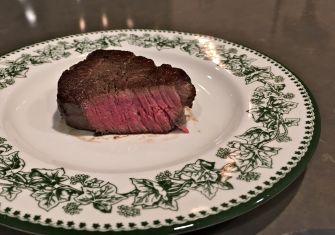 When I first got into Sous Vide cooking, I bought a whole beef tenderloin from Costco. I went home, and simply chopped it into thick steak slices. Then I proceeded to sous vide these, and then to pan-sear them. What turned out wasn’t exactly the filet mignon I was expecting. Parts of the steak were really tender. Parts of the steak were quite tough. Yet other parts had connected tissues that were impossible to chew on.
When I first got into Sous Vide cooking, I bought a whole beef tenderloin from Costco. I went home, and simply chopped it into thick steak slices. Then I proceeded to sous vide these, and then to pan-sear them. What turned out wasn’t exactly the filet mignon I was expecting. Parts of the steak were really tender. Parts of the steak were quite tough. Yet other parts had connected tissues that were impossible to chew on.
It was only after this experience that I spent some time researching tenderloin. And I realized that I bought a whole tenderloin that contained three different pieces of meat: psoas major, psoas minor and iliacus muscle. These pieces were surrounded and connected by fat and tough connective tissues including the dreaded “silver skin”. I didn’t know any of these, and just sliced the unhappy union into steaks. If you want to learn more about these, please visit how to butcher a whole beef tenderloin into filet mignon steaks.
This short article of mine is not about butchering a whole tenderloin. It’s about not having to bother with butchering a whole tenderloin. It turns out that Costco sells processed tenderloin, albeit at a much higher unit price. I found the increased price well worth paying for. This processed version is called “Peeled Extreme Beef Tenderloin”.
WARNING: if you are a vegetarian and do not wish to see more pictures of red meat, do not click on this article. Stop reading now.
Let’s start with a visual comparison of the “whole” tenderloin, compared to the “peeled extreme” version. The whole tenderloin is on the left, while the peeled extreme is on the right (with an upside-down label – sorry about that).
The whole tenderloin is much bigger, and is surrounded by a lot of fat, hiding nasty connective tissues. The unit price is $11 per pound.
Here is the Peeled Extreme Beef Tenderloin. Note the $19 per pound unit price.
If you want to know what a “whole” tenderloin looks like unpacked from the casing, go to how to butcher a whole beef tenderloin into filet mignon steaks. Here I’ll show you what the Peeled Extreme looks like, when removed from the casing.
Right away this looks very different from a whole tenderloin. First of all, almost all fat has been trimmed away. And almost all connective tissues, and especially the silver skins are all peeled off. The psoas minor (aka the “chain”, or the “side muscle”) is also gone. This leaves only the main tenderloin (psoas major) and the “wing” (iliacus muscle).
Some people bundle meat from the wing with the main tenderloin using cooking twine. I have no such thing, so I just cut the wing pieces from the main tenderloin, and stop worrying about creating uniformly round steak slices.
After examining the tenderloin for any remaining silver skins, and removing them, I sliced the tenderloin into ten steaks of varying sizes.
The wing requires some more work before it can be turned into steaks. Examine both sides of the wing. Note the fat, even though I don’t mind having fat on my steak. Fat sometimes hides connective tissues underneath. Look carefully.
Pick out and slice away silver skin using the tip of the knife.
The picture to follow shows the result of trimming. On the upper-right you’ll find, set aside, removed fat, connective tissues and unfortunate collateral damages. These could have been used to make a quick, flavorful soup as I continued to process the wing.
The wing is cut into two pieces, and some more steaks result from the bigger cut.
Dump fat, connective tissue and collateral damage into boiling water. Add ginger and salt. I sliced the smaller cut from above into thin beef slices. Once the beef soup boils, I scooped up and discard those connective tissues. Dump the thin slices into the soup.
You now have a nice beef soup, with tender slices of tenderloin.
Cooking the steak later in vacuum-sealed bags for two hours at 130°F.
Take the steak out of the bag. Pat it dry. Sprinkle salt and pepper. Pan-sear it. Here is the result.

I bought a bigger piece of Peeled Extreme at a later occasion. It turned out that pieces cut from it were a lot more substantial. I think next time I am buying the biggest Peeled Extreme I can find.
The end.



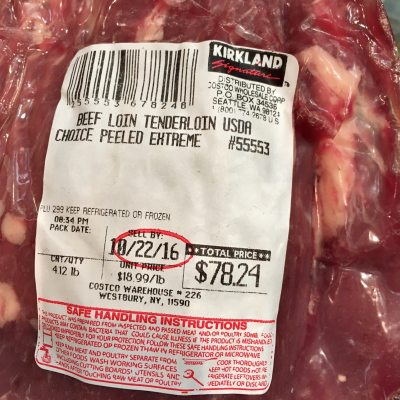

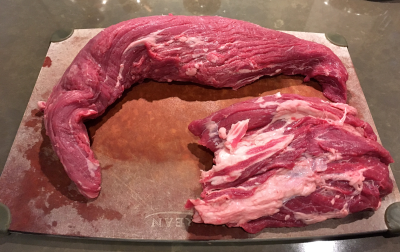








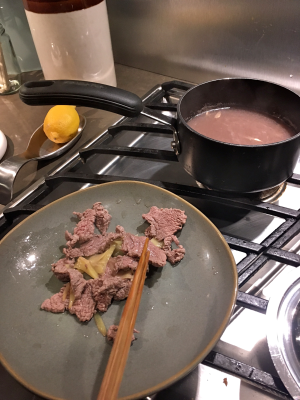
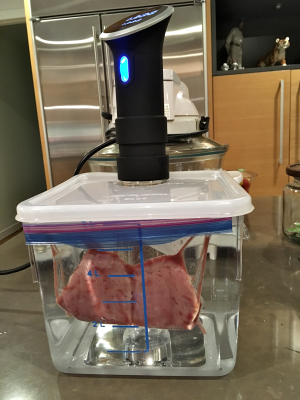
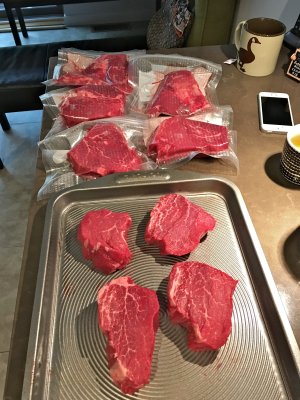

I have worked my entire life as a meat cutter. When I am around people, while camping, they tell me how they buy whole beef ribs at Christmas, whole beef tenderloins, etc. I tell them it’s a better buy to pay more and get the steaks that are trimmed! They always seem to know my business better. A whole rib, when the meat cutter trims off a 2 to 3 inch full length tail, full length chime bone, and then excess fat, the rib that you just paid $6.00 a pound for a special has gone up to $10.00 a pound! Steaks that are trimmed and have no surprises, are sitting beside the low priced roast you bought for $7.99 a pound. Now which is lower priced, a better buy, and you get to,”choose,” from many. This same knowledge applies to beef tenderloin. Beef tenderloin, when trimmed out, silver plate, back strap, and junk ends loses 35% of its special price! You pay for what you get,
.
Dude. That’s so true. Buying a peeled extreme is much more cost-effective than buying a seemingly cheaper whole tenderloin, because after all the removed weight, the cost-per-pound of the “whole tenderloin” is suddenly the same as the peeled extreme, if not even more expensive. And one has to labor to remove these with non-ideal instruments at home, or god forbid, outdoors at a camp site. LOL.
And what you wrote about being able to “choose” is also another key factor in weighing what to buy. As I showed with my pictures, I simply sliced the processed tenderloin into steaks of uneven sizes and shapes. That works for my household of two people. We simply don’t care.
Other people labor to cut them, stitch them, reshape them, and otherwise attempt to produce steaks of equal sizes and similar shapes, for n number of people. Before one knows, one has spent a whole afternoon doing just that. Alternatively, one can simply go to a butcher’s display of cut steaks, “choose”, and pick up whichever pieces they fancy. These perhaps come from many different tenderloins. And this is a luxury one doesn’t get from trying to make the impossible happen with a single tenderloin.
whole peeled beef tenderloin $9.99/lb at Kroger this week
Jan 2024 here, about to cook a piece that I bought about a year ago that is the peeled version. Was on sale (though I don’t remember how much off per package) but the sticker price was still $19.99/lb. Thanks for the explanation here!!
LOL. Enjoy your last cheap tenderloin : )
It’s now $34.99 a pound in 2023. Double the price. Thanks Biden!
Captialism working as intended.
I sure appreciate your guidance on this!
Still a good read 12/22, thanks for breaking this down.
Thanks for leaving your appreciation :)
Reading in 12/2023. I came here confused by Costco’s offerings (wth is “peeled” tenderloin?) and left w/Masters degree in what to expect/do. Sincerely, thank you.
just like the steak
Seeing this in 2020 and it’s still legit! Great stuff!
Hey. Great to know that the article still applies. That reminds that we haven’t grilled steak for a while. I should do that before the onset of colder weather.
As with all the folks above, I’ll add my sincere thanks to you for time and effort you took to write such a good teaching article…..and with photos!
Thank you, John :)
Thank you so much for this! Looked everywhere online for how exactly to handle Costco’s peeled extreme tenderloin and your walk-through was incredibly helpful. Much appreciated.
I am glad you found it useful. Cheers. And enjoy your steak :)
Just bought an “extreme at Costco” ($30 instant rebate, so $12/lb) and after being perplexed by what came out of the plastic, asked google to find something and you came up on top. What time & temp on the sous vide? Great article, thanks.
I am glad you found this useful at the time you need it. I followed the convention for the temperature. That is, 130°F for a medium rare result. As for time, I think it’s up to your personal preference. I’ve tried many different time settings ranging from 1 hour to 4 hours. I don’t chop my steak into thick slabs. You can see the average thickness of my steaks from my pictures in this article. Basically, after an hour the steak is OK for browning, especially if you don’t wait for it to cool down before you put it on the grill.
If you sous vide it for 4 hours, you’ll get a buttery texture that melds in your mouth. It’s a strange feeling and hard to describe. Why don’t you give it a try? I consulted this: http://www.seriouseats.com/2015/06/food-lab-complete-guide-to-sous-vide-steak.html. I like the way they approached this research.
Yesterday, Oct.23, my wife and I visited Costco in Mt. Laurel, NJ. We looked over the fresh meat and were interested in the whole filets. I looked at both prime and choice and decided that I would prefer to purchase prime. I asked the meat person what the “extreme peeled” meant…she told me that she thought that it was removing the extra fat but that she really wasn’t sure. We asked if that included the silver skin, to which she replied she didn’t know what that was. My wife walked away. I was too nice to tell her she really should know what she is selling or, learn from someone in the department that knows what they are doing. I’m going to ask in the future if there is a resident butcher who can answer these types of basic questions. Thanks so much for doing their work for all of us. What an excellent education you gave my wife and me and Costco should ask permission to put your article up in each of their stores. Thanks, Xinhai Dude 辛亥生網誌
Thanks for the kind words. Much appreciated. I try to write things I wish other people had written. Most of the times I find useful information online, when I can’t get them directly from real world interactions like you described. But there are times when even Google fails me. That’s how half of my posts are born. The rest half are random musings :)
Xinhai Dude 辛亥生網誌, thank you so much for such a detailed and instructive posting. I made the serious mistake of purchasing regular whole tenderloins and made the biggest mess out it because I had no real idea of the details your outlined. The added cost of the peeled extreme cut is well worth the additional cost when you consider the added waste and amount of time to prepare the tenderloin. Costco should add your posting at every store’s meat department.
Thanks for the kind words. I am glad you stumbled upon this article I wrote.
Excellent explanation of “peeled extreme” from Costco
very good ! Thank you.